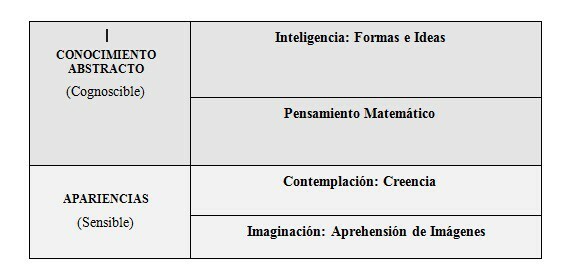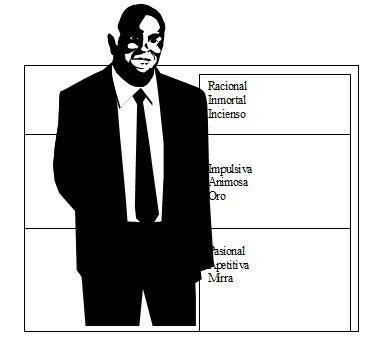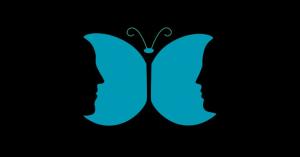Plato's Impressive Contributions to Psychology
Psychology also draws on the contribution of numerous thinkers, writers, and philosophers.
In this article we will explain Plato's contributions to Psychology: his vision of knowledge, the rational soul, the psychic structure and his influence on the science of human behavior. A historical figure whose ideas are still valid today.
Plato (428-348) and his contributions to Psychology
Plato He was born in the period of peace and splendor of the democracy of Pericles. Belonging to the Athenian aristocracy, he received the education of a young man of the upper class (gymnastics and poetry, mainly). He was also one of the most fervent disciples of Socrates until his death ("The wisest, best and most just of men", in his opinion). He traveled by Greece and Egypt, receiving the capital influences of the mathematician Theodore, as well as of the Orphic, Pythagoreans, and Eleatas: Heraclitus and Parmenides.
Plato founded the Akademia, dedicating his life to teaching the Philosophy. He accepted Parmenides' relativism concerning the
perception. (Three buckets of water in a line: hot, warm and cold: inserting one hand into each of the buckets extremes and then both in between, the one who was in the cold will feel hot, and the one who was in the hot cold.). Plato would also accept the Heraclitean doctrine of flow, arguing that all objects are in constant change, so it is impossible to know them. Knowledge for Plato is of the eternal and immutable (Being of Parmenides) and, therefore, there is no knowledge of perishable things.The world of ideas
Plato named Shapes or Ideas to the objects of immutable knowledge. There is a Shape for every kind of object for which there is a term in the language (eg, "cat," round, etc). Plato believed that the objects perceived were imperfect copies of these Forms, since those are in permanent change and are relative to the one that he perceives them (importance of language shaping reality: concepts are the only immutable thing, they are related to Forms and they are not conventional).
An example of this idea appears in the metaphor of the line, belonging to The Republic (Fig. 1). Let's imagine a line divided into four unequal segments. The line is divided into two large segments that represent the world of perceived Appearances and opinion, and the world of abstract Knowledge, or intelligible world. The first segment is shorter, to denote its imperfection. The world of Appearances is divided, in turn, in equal proportions, into the world of Imagination and that of Belief.
Imagination is the lowest level of cognitionas it deals with simple images of concrete objects, analogous to reflections that fluctuate in water. Plato banished the Art of the republic from him, relegating it to this imaginary plane.

The eternal epistemological debate
For Plato, the apprehension of images or imagination is the most imperfect form of knowledge. He is followed by the contemplation of the objects themselves; The result of this observation he called Belief. With the next segment, Thought, mathematical knowledge begins. The mathematician has a general knowledge of things. The ideal world of Geometry is very similar to the world of Forms (or Ideas): the Pythagorean theorem (the square of the hypotenuse of a right triangle is equal to the sum of the squares of the legs) refers to the Right Triangle, and any particular example will be a lower copy of the Right Triangle perfect. Plato believed that the relationship between copy and form was true, however, in all cases.
For Plato the last segment, the higher form of knowledge (Intelligence or Knowledge) is of a higher level than mathematical knowledge. Indeed, mathematical thinking produces knowledge within its system of premises, but since it cannot know if its premises are correct (the starting axioms as A = A), it cannot constitute the true knowledge.
To achieve knowledge we must go back higher, to the realm of Forms, to the fundamental principles. His position on this scheme of knowledge evolved throughout his life. In the early dialogues, Plato believed that the experience of concrete objects stimulated the recollection of the innate knowledge of the forms, although imperfectly, being therefore real stimuli to awaken our knowledge.
In the Intermediate dialogues, he denied any valid role to sensory perception and confined knowledge to abstract and philosophical dialectics. Finally he returned to his first belief in the potential value of sensory perception. He also elaborated his notion of dialectics, turning it into an instrument to classify with precision all things. At the same time his conception of Forms became more and more mathematical and Pythagorean.
The problem posed by Plato in the theory of Forms has preoccupied some researchers of modern cognitive psychology about concept formation. Trait theory states that each concept is made up of a series of traits, some of which are essential and some of which are not. Prototype theory states that the concept is built around a prototype or formula. The Form could be considered the prototype of which the concrete cases are imperfect replicas (myth of The Cave).
Psychic structure
Plato divided the soul, or mind, into three parts. First there was the immortal or rational soul, located in the head. The other two parts of the soul are deadly: The Impulsive or spirited soul, oriented to conquer honor and glory, is located in the thorax, and the Passionate and appetizing soul, interested in bodily pleasure, in the womb (Fig. 2).

The Rational soul it is related to Forms and knowledge. It is his duty to control the wishes of the other two, just as the charioteer controls two horses. The Passionate soul was, for Plato, particularly in need of subjection on the part of reason. (analogy with the Freudian psychic apparatus: it-me-super-me).
Plato is greatly influenced by the oriental tradition that also appears in the myth of the Magi. They offer the child three chests to find out if her nature is human, real or divine. The content of the chests is the material substance corresponding to each of these natures: myrrh - red gum resin -, gold and incense.
Motivation
Plato has a poor conception of pleasure - Pythagorean inheritance -: the body seeks pleasure and avoids pain, this only hinders the contemplation of the Good. In his later writings, some pleasures, such as the aesthetic enjoyment obtained from Beauty, are considered healthy, rejecting the purely intellectual life as too limited.
His conception of his motivation is almost Freudian: we have a stream of passionate desires that can be channeled to any part of the soul, to pleasure, personal achievement, or philosophical knowledge and virtue. The impulses can motivate the search for transitory pleasure or the philosophical ascent to the world of Forms.
Physiology and perception
Given his distrust of perception, he hardly spoke of the Physiology, empirical science. His ideas on the matter were conventional among the Greeks. Vision, for example, is due to the emission of visual rays by our eyes that affect objects located in the visual path.
Learning: innateness and associationism
Plato was the first great nativist. Since according to him all knowledge is innate, it must exist in every human being from birth. The objects perceived are similar to the Forms in which they participate, and this similarity, together with the instruction, stimulates the Rational soul to remember what the Forms are like (Anamnesis). (Analogy with the Chomskyan language theory, according to which linguistic competence is innate).
Plato also lays the foundations of the associationist doctrine, later a fundamental part of atomism and empiricist philosophy. The relationship between objects and Forms obeys two aspects: formal similarity and presenting themselves as associated in our experience, that is, contiguity. They correspond to the syntagmatic and paradigmatic dimensions described by Jakobson as constitutive of the language structure.
They are also the laws of the Unconscious, or its basic operations: metaphor as condensation and metonymy as displacement. (Production Aphasia –Broca– versus Comprehension Aphasia –Wernicke–). (Analogy with the two types of magic that Frazer describes: Contaminant Magic –by contiguity- and Contagious –by similarity-)
Development and education
Plato believed in reincarnation -metempsychosis-. When dying, the rational soul separates from the body and reaches the vision of the Forms. According to the degree of virtue achieved, it is then reincarnated somewhere on the phylogenetic scale. When the soul is reincarnated in a body full of needs and sensations, it falls into a state of confusion. Education consists in helping the Rational soul to gain control of the body and the other parts of the soul.
Plato's main disciple, Aristotle, would develop the first systematic psychologyto.

